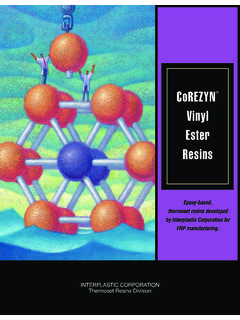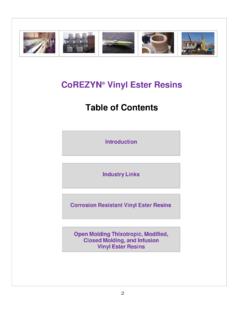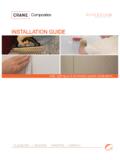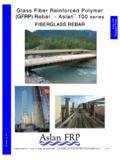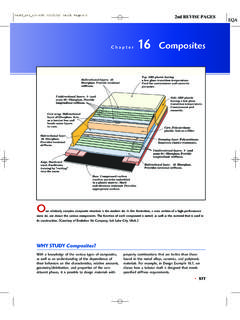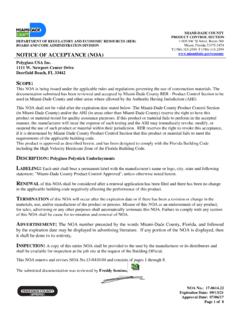Transcription of Technical Research - Composites, Cast Polymer, …
1 Technical ResearchProper Cure ofVinyl Ester ResinsINTERPLASTIC CORPORATIONT hermoset Resins DivisionCoREZYN Premium Vinyl Ester MoleculeComplete cure of a resin is critical to achieving theoptimum corrosion resistance and physical proper-ties of a laminate. Typical composites are made inthicknesses ranging from in. ( mm) in. ( mm). Previous work has shown thathigher catalyst levels yield a higher degree of curefor thin panels made at 77 F (25 C). However,fiberglass reinforced plastic/glass reinforced plastic(FRP/GRP) products are made under a variety oftemperatures and cure conditions.
2 This study wasdone to help FRP/GRP manufacturers addressparameters that they can control to make qualityparts under a variety of parameters were evaluated in a designedexperiment. These parameters are critical to making a quality part in hand lay-up, spray-up andother processes. Two of the controllable parame-ters are catalyst and promoter levels. The thirdparameter, temperature, is independent of the othertwo. This study shows how the FRP/GRP manufac-turer can design a promoter/catalyst package toyield quality parts even under adverse tempera-tures and ambient conditions.
3 Most FRP/GRP fabricators using vinyl ester resin intheir construction process manufacture laminatesless than in. ( ) thick. Applications forthese thin laminates range from corrosion barriersin tanks, pipe, and ducting, to skin coats used inswimming pools, boats, spas, and in sandwichcomposites. The performance of the composite isdependent upon the cure of the resin. Resin manu-facturers offer many of these resins promoted,however many fiberglass shops prefer to designtheir own catalyst promoter systems. Fabricatorscommonly increase the level of catalyst to improvethe cure.
4 Understanding these systems can helpfabricators select a combination of catalyst and promoters that are right for their significant amount of fabrication is done at temperatures below 77 F (25 C). This is especiallytrue in the spring, fall and winter seasons. Lowtemperatures are detrimental to the final cure ofresins and final cure is especially critical in thinlaminates. Air, resin and mold temperature in-fluence resin cure. Mold temperature is the mostimportant factor, since a cool surface can quicklylower the temperature of the resin and lengthensthe gel time.
5 While growth in thin laminate manufacturing contin-ues to increase, there have not been any recent stud-ies exploring how to optimize the cure cross sections do not generate exotherms ofmore than 104 F (40 C). Previous work with thicklaminates showed exotherms ranging from 99 F(37 C) to 334 F (168 C). High exotherms have beenshown to yield higher Tg thin laminates donot reach the same temperatures as their thick coun-terparts, they require an optimized catalyst promoterpackage to generate thoroughly cured composites. Catalyst/promoter packages are combinations of addi-tives that have a synergistic relationship in thecrosslinking reaction.
6 The optimum levels of thesecomponents can help FRP/GRP manufacturers bringthe best possible products to market. Another method used to increase the resin s crosslinkdensity is to post-cure the parts. Typically fiberglassshops don t post-cure parts unless they are specifi-cally requested or required to because it creates anadditional step and cost. While today s competitivemarket has driven companies to be cost conscious,they still need a means to generate a thoroughlycured are instances where composites are trans-ferred to storage areas at temperatures below 50 F(10 C) or put in service before they are three daysold.
7 Shifting composites to cooler environments canslow and even stop the reaction from reaching theoptimum level of cure. Post-curing the parts at thispoint may not increase the hardness, degree of cureand glass study explored the catalyst and promoter selec-tion and their levels at various temperatures. Typicallevels of the following common catalyst promoter systems will be discussed: methyl ethyl ketone perox-ide (MEK P)/cobalt octoate/N, N-dimethylaniline(DMA) and benzoyl peroxide (BPO)/DMA. Temp-eratures of 59 F (15 C), 68 F (20 C) and 77 F (25 C)were experiments, optimizing a few parameters,were set up similar to previous experi-ments were used to investigate the effects of the catalyst/promoter packages over a range of normaloperating temperatures.
8 Models of data were used to predict the levels of the catalyst and promotersrequired to yield a highly cured composite at techniques were used to evaluate the resincure:1. Glass transition temperature determined bydynamic mechanical analysis,4,5 ABSTRACTINTRODUCTION12. degree of cure by differential scanning calori-metry (DSC)6and, 3. laminate hardness by Barber-Coleman Barcolimpressor physical properties of the laminates werealso checked to find if the catalyst/promoter package and the temperature affected resin was a non-promoted, bisphenol-A,epichlorohydrin-based, vinyl ester with a viscosityof 450 centipoise at 45% styrene.
9 Appropriate levels of the promoters were added to the resin foreach experiment. The promoters used were: 12%cobalt octoate and N,N-Dimethylaniline (DMA). Themethyl ethyl ketone peroxide (MEKP) catalyst usedwas L-50 (Akzo Chemie.) and the benzoyl peroxide(BPO) was ANS-55 (Arkema, Inc.). L-50 was cho-sen because it is an MEKP catalyst specificallydesigned to work well with vinyl ester resins. ANS-55 was selected because it does not contain highlevels of water or plasticizers as diluents that caninfluence the physical and corrosion resistanceproperties of the experiments were a custom central compositedesign.
10 One design included eleven experiments,the eight corners of the cube and three replicationsof the center point. The other design was used forthe physical properties in which seven experimentswere used and incorporated four corners and threecenter points. The models of the data were com-puted without any transformation of the and cubic equations were used for themodels because they provided the best fit for thedata. The experiments were set up and analyzedwith a program entitled Design Expertby Stat-Ease. A flat, rectangular, aluminum mold 1 in. ( cm)deep by approximately 47 (305 cm2) was usedto construct the laminates.
